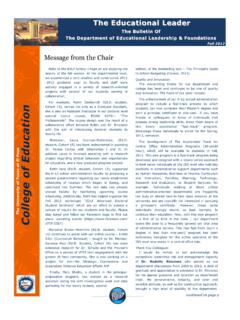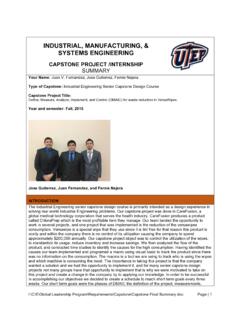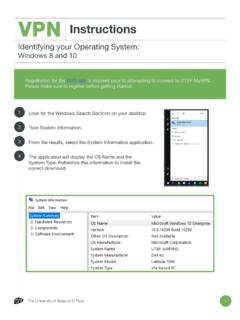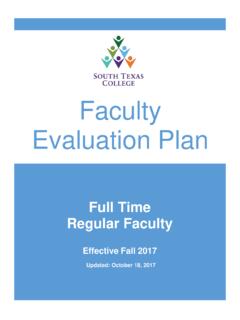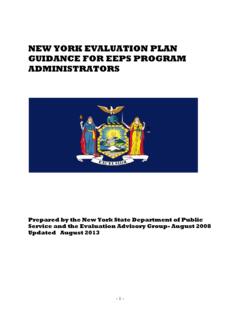Transcription of Writing an Evaluation Plan - utep.edu
1 Writing an Evaluation plan Guadalupe Corral, PhD Office of Research & Sponsored Projects Proposal Development Team Why Evaluate? Funding sources require and you also need to know To improve your program/project To see the impact of your program Where do you start? Analyzing the Solicitation What is the solicitation asking for? Differs within and between agencies NSF Describe how the research and education will be evaluated (internally and/or externally). NSF All proposals must include an appropriate Evaluation plan . A number of resources for developing Evaluation plans are available at including the 2010 User-Friendly Handbook for Project Evaluation , Framework for Evaluating Impacts of Informal Science Education Projects (Framework), and the Impacts and Indicators Worksheet.
2 Evaluation design: Evaluation questions, design, data collection methods, analyses, and reporting/dissemination strategies must be detailed in the Evaluation plan , including formative and summative Evaluation goals and strategies that seek to answer the Evaluation questions. The Evaluation design must emphasize the coherence between the proposal goals and evidence of meeting such goals, and must be appropriate to the type, scope, and scale of the proposed project. Logic models or theories of action, as an example, can help describe the project inputs, outputs, outcomes and impacts. All project types must include a summative Evaluation by an external evaluator. NOTE: details of the Evaluation plan may be included as a Supplementary Document.
3 Analyzing the Solicitation NIH Evaluation plan (6 pages, total) Provide a comprehensive Evaluation plan to be used to monitor the conduct and track the progress of proposed TCC research, implementation and dissemination activities. Describe how the Evaluation will be conducted, the principal measures and metrics to be used, and the potential sources of data. Also include a detailed self- Evaluation plan to assess achievement of short- and long-term TCC goals. The Administrative Core is responsible for implementing the Evaluation plan . Since the major purpose of the Evaluation is to provide information to assist with TCC planning and management, the plan should address both administrative and scientific function and accomplishments.
4 The Evaluation plan should address the following areas of particular importance: translational activities; scope and impact of research; innovation; collaboration and communication; integration and synergy; and funds management. Describe timelines, key milestones and expected outcomes for each area as appropriate. While Evaluation should be a continuous process, a formal Evaluation by an outside, independent group selected by TCC leadership and approved by NIMHD staff should be conducted at least every two years. TCCs may also be called upon to gather data and participate in the development of a national TCC Program Evaluation . Analyzing the Solicitation Types of Evaluations Internal Independent External Types of Evaluations Formative Evaluation , two components: Implementation (or process) Evaluation Progress Evaluation Provides information to improve programs Types of Evaluations Summative Evaluation Did the program meet its goals and objectives?
5 What evidence can serve to show this? Baseline information Summative information Developing the Evaluation plan Program context What is the problem or need for the program? What are the goals and objectives of your program? Who is involved? What activities will take place? How will you measure progress and impact? Selecting Indicators for Assessment What do you expect to see if program/project is correctly implemented and progresses toward stated objectives? Implementation: Recruitment Selection Participation: Activities Assessments * Researchers: Program plan Meetings Select Appropriate Indicators Quantitative Data Provide for easy comparisons; can come from existing or created sources Records Surveys Learning assessments Thought should be given to validity and reliability Qualitative Data Provide for descriptions about program activities, context, and participants behaviors Document review Observations Focus Groups Interviews Open-ended questions on surveys Have guidelines in place Create a Logic Model Illustrate the relationship among your program/project elements: Inputs: Resources necessary for program implementation Activities: Interventions that will be implemented to achieve outcomes Outputs: Direct products obtained as a result of program activities Create a Logic Model Outcomes.
6 The impacts, changes, or results of the program activities and outputs; link to your objectives and your goals Short-term: knowledge skills attitudes motivation awareness Intermediate-term: behaviors practices policies procedures Long-term: environmental social conditions economic conditions political conditions Create a Logic Model Create a Logic Model Don t assume Don t get too complex Don t get too fancy Don t overdo it Keep it Simple! Keep it Simple! Tips for Writing your plan Know your audience Drop the jargon and be straightforward, clearly stating what you plan to do Try to incorporate both quantitative and qualitative data collection methods Be honest, note any challenges you may face and how you may overcome these Writing your plan Two examples Budgeting for the Evaluation May range from 5 10% (or more)of the grant amount Evaluation Activities Consultation and analysis Development of plan Literature review Coordination with stakeholders Data requests Periodic and final reports Etc.
7 Development of measures Surveys Interview and focus group questions & logistics Tests Etc. Data collection Data analysis & results American Evaluation Association: Institute of Organizational and Program Evaluation Research: Finding an Evaluator Sources Bond, Sally L., Boyd, Sally E., and Rapp, Kathleen A. 1997. Taking Stock: A Practical Guide to Evaluating Your Own Programs. Horizon Research, Inc., Chapel Hill, NC. Frechtling Westat, Joy. 2002. The 2002 User Friendly Handbook for Project Evaluation . National Science Foundation. McCawley, Paul F. 2001. The Logic Model for Program Planning and Evaluation . University of Idaho Extension. National Institute of Environmental Health Sciences & Department of Health and Human Services.
8 2012. Partnerships for Environmental Public Health Evaluation Metrics Manual NIH. Publication No. 12-7825. Shackman, Gene, 2009. What is Program Evaluation ? A beginners guide. The Global Social Change Research Project. Questions?
